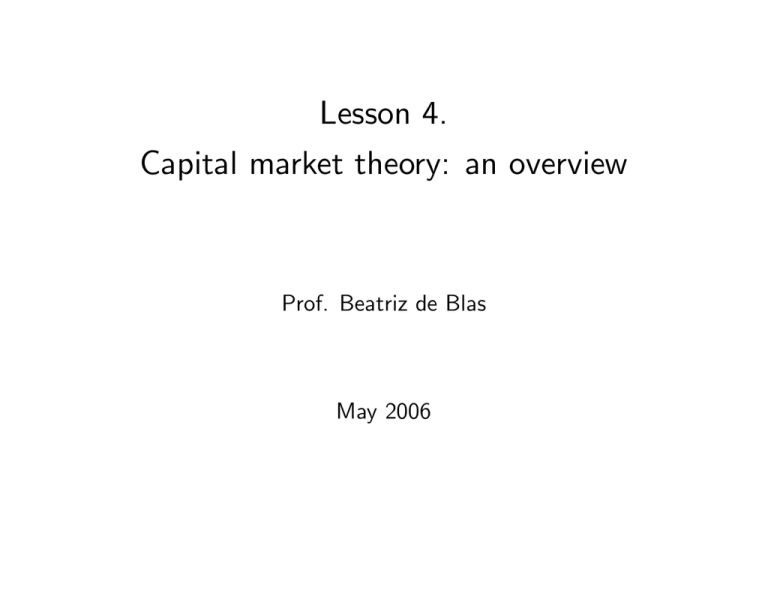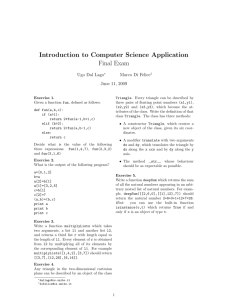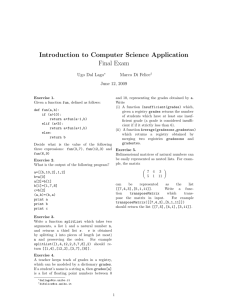
Lesson 4.
Capital market theory: an overview
Prof. Beatriz de Blas
May 2006
4. Capital market theory: an overview
Introduction
Previous lessons: discount rate for risk-free assets
Next: determine discount rate for risky projects
Need to measure risk
– measure risk of an asset (Chapter 9)
– measure risk of a portfolio (Chapter 10)
Plan of the lesson:
8
>
< 1. Returns
2. Holding-period returns
>
: 3. Return statistics
2
4. Capital market theory: an overview
1. Returns
1. 1. Dollar returns
The return got on an investment
%
&
Dividend to shareholders (income component)
Capital gain (or capital loss): change in market value
Total dollar return = Dividend income + Capital gain (or loss)
3
4. Capital market theory: an overview
4
2. 1. Percentage returns
Summarize information about returns in percentage terms than in dollars.
How much return do we get for each $ invested? Let Pt be the beginning
market value
Dividend yield =
Divt+1
Pt
(Pt+1 Pt)
Capital gains yield =
Pt
Divt+1 (Pt+1 Pt)
Total percentage return: Rt+1 =
+
Pt
Pt
4. Capital market theory: an overview
5
Example: Suppose you bought 100 shares of Wal-Mart (WMT) one year ago
today at $25: Over the last year, you received $20 in dividends (= 20 cents
per share 100 shares). At the end of the year, the stock sells for $30: How
did you do?
4. Capital market theory: an overview
6
Example: Suppose you bought 100 shares of Wal-Mart (WMT) one year ago
today at $25: Over the last year, you received $20 in dividends (= 20 cents
per share 100 shares). At the end of the year, the stock sells for $30: How
did you do?
Quite well. You invested
$25
100 = $2; 500
At the end of the year, you have stock worth $3; 000 and cash dividends
of $20: Your dollar gain was
$520 = $20 + ($3; 000
What is your percentage gain?
$2; 500)
4. Capital market theory: an overview
7
Example: Suppose you bought 100 shares of Wal-Mart (WMT) one year ago
today at $25: Over the last year, you received $20 in dividends (= 20 cents
per share 100 shares). At the end of the year, the stock sells for $30: How
did you do?
Quite well. You invested
$25
100 = $2; 500
At the end of the year, you have stock worth $3; 000 and cash dividends
of $20: Your dollar gain was
$520 = $20 + ($3; 000
Your percentage gain for the year is 20:8% =
$2; 500)
$520
$2; 500
4. Capital market theory: an overview
8
2. Holding-period returns
The holding period return is the return that an investor would get when holding
an investment over a period of n years, when the return during year i is given
as ri :
holding period return = (1 + r1)
(1 + r2)
:::
(1 + rn)
1
4. Capital market theory: an overview
9
Example: Suppose your investment provides the following returns over a fouryear period:
Year Return
1
10%
2
5%
3
20%
4
15%
then, your holding period return is
4. Capital market theory: an overview
10
Example: Suppose your investment provides the following returns over a fouryear period:
Year Return
1
10%
2
5%
3
20%
4
15%
then, your holding period return is
(1 + r1)
(1:10)
(0:95)
(1 + r2)
(1:20)
(1 + r3)
(1:15)
(1 + r4)
1=
1 = 0:4421 = 44:21%
4. Capital market theory: an overview
11
An investor who held this investment would have actually realized an annual
return of 9:58% :
(1 + rg )4 = (1 + r1)
q
4
(1:10)
(0:95)
(1 + r2)
(1:20)
(1:15)
(1 + r3)
(1 + r4) =
1 = 0:0958 = 9:58%
So, our investor made 9:58% on his money for four years, realizing a total
period return of 44:21%
1:4421 = (1:095844)4
9-11
The Future Value of an Investment
of $1 in 1925
$1,775.34
1000
$59.70
$17.48
10
Common Stocks
Long T-Bonds
T-Bills
0.1
1930
1940
1950
1960
1970
1980
1990
2000
Source: © Stocks, Bonds, Bills, and Inflation 2003 Yearbook™, Ibbotson Associates, Inc., Chicago (annually updates work by
Roger G. Ibbotson and Rex A. Sinquefield). All rights reserved.
McGraw-Hill/Irwin
Corporate Finance, 7/e
© 2005 The McGraw-Hill Companies, Inc. All Rights Reserved.
9-13
Historical Returns, 1926-2002
Series
Average
Annual Return
Standard
Deviation
Large Company Stocks
12.2%
20.5%
Small Company Stocks
16.9
33.2
Long-Term Corporate Bonds
6.2
8.7
Long-Term Government Bonds
5.8
9.4
U.S. Treasury Bills
3.8
3.2
Inflation
3.1
4.4
Distribution
– 90%
0%
+ 90%
Source: © Stocks, Bonds, Bills, and Inflation 2003 Yearbook™, Ibbotson Associates, Inc., Chicago
(annually updates work by Roger G. Ibbotson and Rex A. Sinquefield). All rights reserved.
McGraw-Hill/Irwin
Corporate Finance, 7/e
© 2005 The McGraw-Hill Companies, Inc. All Rights Reserved.
4. Capital market theory: an overview
12
3. Return statistics
The history of capital market returns can be summarized by describing
average stock return
(R1 + ::: + RT )
R=
T
the std. deviation of those returns
std:dev: =
p
var =
s
(R1
frequency distribution of the returns
R)2 + ::: + (RT
T 1
R )2
4. Capital market theory: an overview
13
Risk premium: average stock returns and risk-free returns
The risk premium is the additional return (over and above the risk-free
rate) resulting from bearing risk.
In the data (1926-1999): long-run excess of stock return over the risk-free
return.
Rate of return on T-bills is essentially risk-free.
The di¤erence between the return on T-bills and stocks is the risk premium
for investing in stocks.
The risk-return tradeo¤
9-16
The Risk-Return Tradeoff
18%
Small-Company Stocks
Annual Return Average
16%
14%
Large-Company Stocks
12%
10%
8%
6%
T-Bonds
4%
T-Bills
2%
0%
5%
10%
15%
20%
25%
30%
Annual Return Standard Deviation
McGraw-Hill/Irwin
Corporate Finance, 7/e
© 2005 The McGraw-Hill Companies, Inc. All Rights Reserved.
35%
9-17
Rates of Return 1926-2002
60
40
20
0
-20
Common Stocks
Long T-Bonds
T-Bills
-40
-60 26
30
35
40
45
50
55
60
65
70
75
80
85
90
95 2000
Source: © Stocks, Bonds, Bills, and Inflation 2000 Yearbook™, Ibbotson Associates, Inc., Chicago (annually updates work by
Roger G. Ibbotson and Rex A. Sinquefield). All rights reserved.
McGraw-Hill/Irwin
Corporate Finance, 7/e
© 2005 The McGraw-Hill Companies, Inc. All Rights Reserved.


